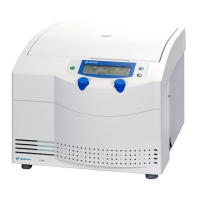Operating Manual SIGMA 2-16P page 52 of 75
04/2007
7.2.1 Autoclaving
The service life of the accessories essentially depends on the frequency of
autoclaving and use.
• Replace the accessories immediately when the parts show changes in color
or structure or in the occurrence of leaks etc.
• During autoclaving, the caps of the tubes must not be screwed on in order to
avoid the deformation of the tubes.
It cannot be excluded that plastic parts, e.g. lids or carriers, may deform during
autoclaving.
Autoclaving:
Accessories max. temp.
°C
min. time
min
max. time
min
max.
cycles
Glass tubes 134-138 3 40 -
Polycarbonate tubes 115-118 30 40 20
Polypropylene tubes 115-118 30 40 30
Teflon tubes 134-138 3 5 100
Aluminum rotors 134-138 3 5 -
Polycarbonate/Polyallomer
lids for angle rotors
115-118 30 40 20
Polysulfone lids for angle
rotors
134-138 3 5 100
Aluminum buckets 134-138 3 5 -
Polycarbonate caps for
buckets
115-118 30 40 50
Polypropylene caps for
buckets
115-118 30 40 50
Polysulfone caps for buckets 134-138 3 5 100
Rubber adapters 115-118 30 40 -
Rubber cushions 115-118 30 40 -
Round carriers made of
polypropylene
115-118 30 40 -
ditto, made of polyallomer
and polycarbonate
115-118 30 40 -
Rectangular carriers made of
polypropylene
115-118 30 40 -
ditto, made of polyallomer
and polycarbonate
115-118 30 40 -
Fi
. 7.1: Autoclavin
table

